University Restaurant Dining Consumption Literature Review Analysis
VerifiedAdded on 2023/01/05
|7
|1724
|79
Report
AI Summary
This literature review examines dining consumption in a restaurant context, drawing on seven peer-reviewed articles. It explores the interconnectedness of service quality and customer satisfaction, as highlighted by authors like Ma, Qu, and Eliwa. The review traces the evolution of service quality, encompassing factors beyond food quality, such as ambiance, cuisine knowledge, and brand image. Common themes include the impact of service quality on profitability, while different articles propose various methods for enhancement, from artistic food presentation to effective communication. The review also discusses study limitations, such as reliance on surveys and a lack of diverse data collection methods. It suggests future research directions, including the use of interviews and a broader consideration of factors influencing service quality. The articles emphasize the importance of brand image and customer treatment on satisfaction and loyalty.
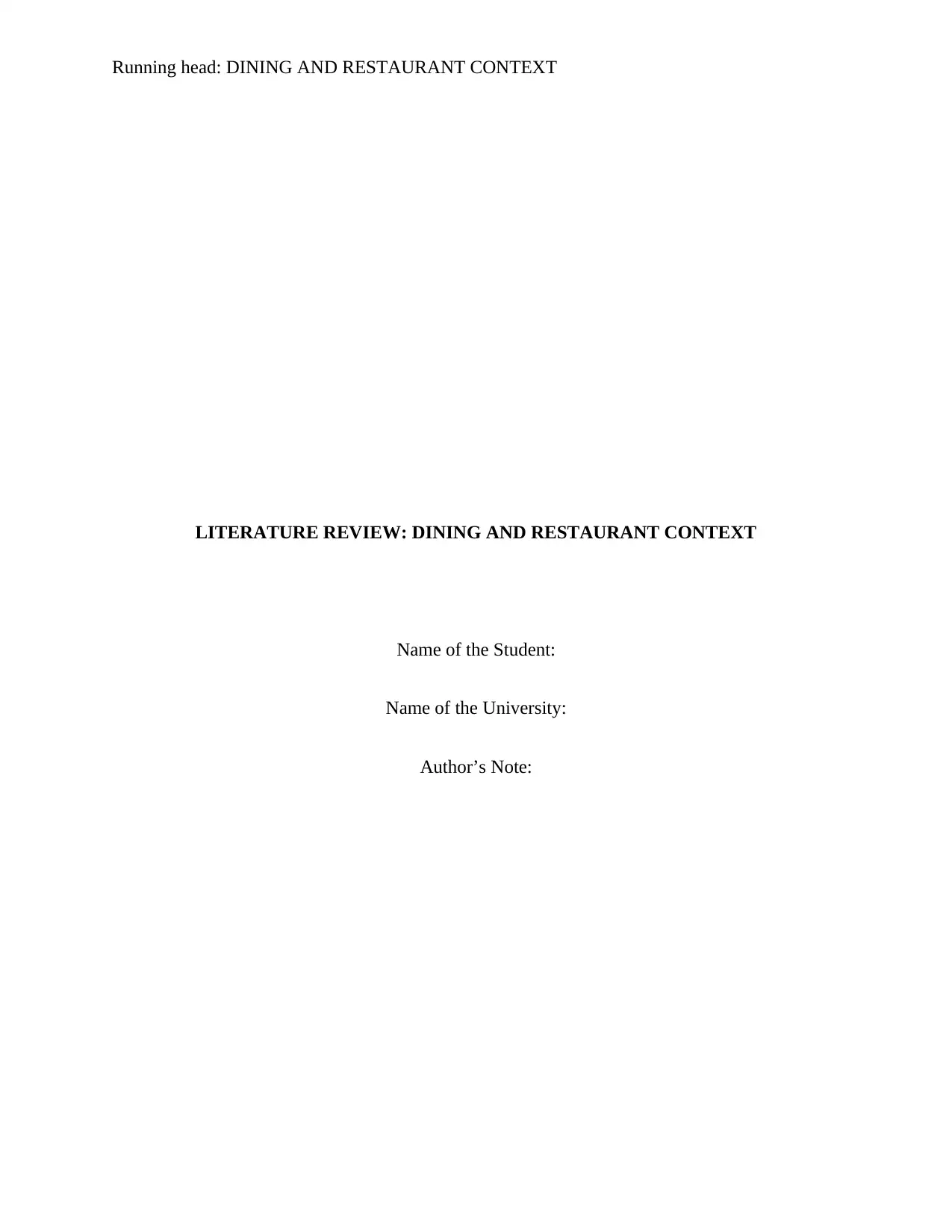
Running head: DINING AND RESTAURANT CONTEXT
LITERATURE REVIEW: DINING AND RESTAURANT CONTEXT
Name of the Student:
Name of the University:
Author’s Note:
LITERATURE REVIEW: DINING AND RESTAURANT CONTEXT
Name of the Student:
Name of the University:
Author’s Note:
Paraphrase This Document
Need a fresh take? Get an instant paraphrase of this document with our AI Paraphraser
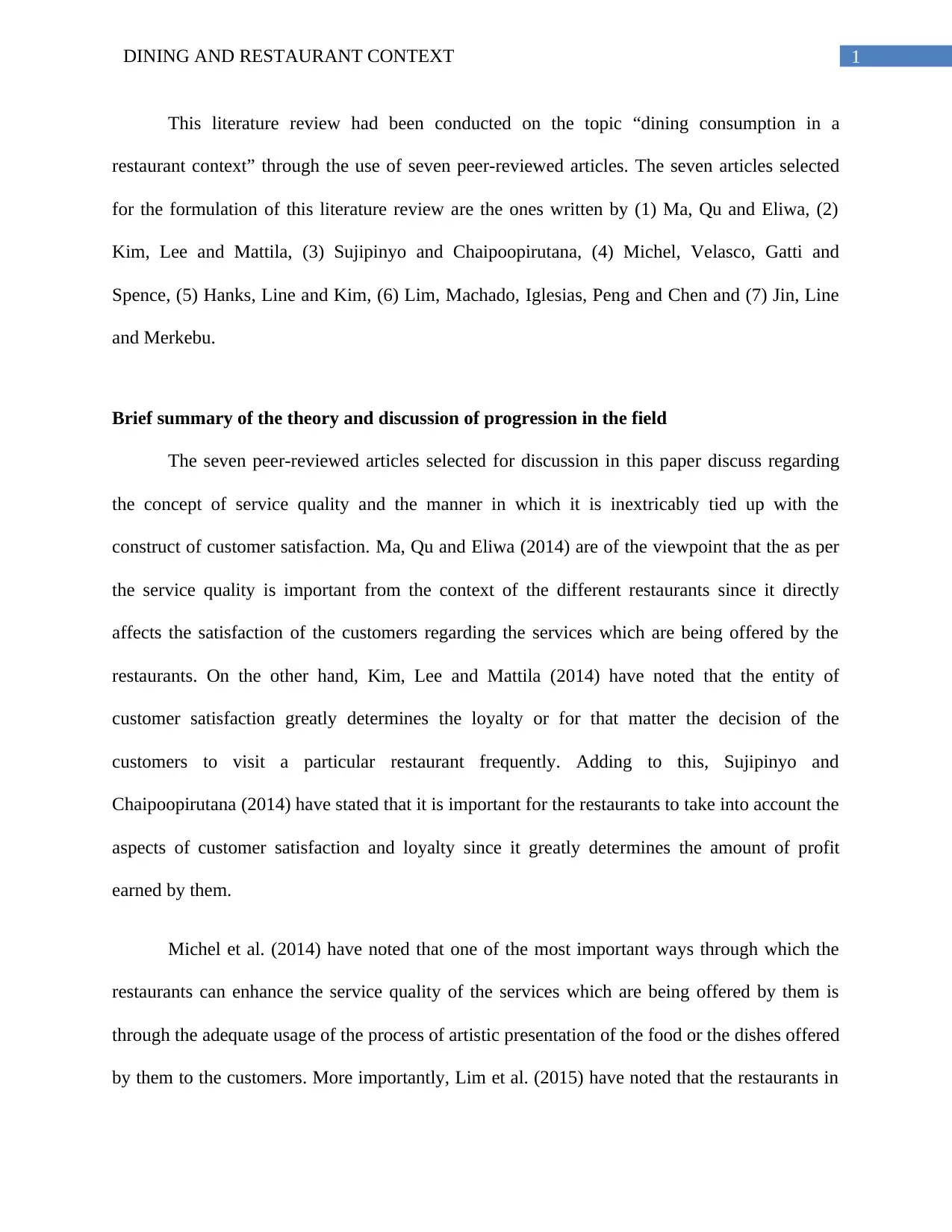
1DINING AND RESTAURANT CONTEXT
This literature review had been conducted on the topic “dining consumption in a
restaurant context” through the use of seven peer-reviewed articles. The seven articles selected
for the formulation of this literature review are the ones written by (1) Ma, Qu and Eliwa, (2)
Kim, Lee and Mattila, (3) Sujipinyo and Chaipoopirutana, (4) Michel, Velasco, Gatti and
Spence, (5) Hanks, Line and Kim, (6) Lim, Machado, Iglesias, Peng and Chen and (7) Jin, Line
and Merkebu.
Brief summary of the theory and discussion of progression in the field
The seven peer-reviewed articles selected for discussion in this paper discuss regarding
the concept of service quality and the manner in which it is inextricably tied up with the
construct of customer satisfaction. Ma, Qu and Eliwa (2014) are of the viewpoint that the as per
the service quality is important from the context of the different restaurants since it directly
affects the satisfaction of the customers regarding the services which are being offered by the
restaurants. On the other hand, Kim, Lee and Mattila (2014) have noted that the entity of
customer satisfaction greatly determines the loyalty or for that matter the decision of the
customers to visit a particular restaurant frequently. Adding to this, Sujipinyo and
Chaipoopirutana (2014) have stated that it is important for the restaurants to take into account the
aspects of customer satisfaction and loyalty since it greatly determines the amount of profit
earned by them.
Michel et al. (2014) have noted that one of the most important ways through which the
restaurants can enhance the service quality of the services which are being offered by them is
through the adequate usage of the process of artistic presentation of the food or the dishes offered
by them to the customers. More importantly, Lim et al. (2015) have noted that the restaurants in
This literature review had been conducted on the topic “dining consumption in a
restaurant context” through the use of seven peer-reviewed articles. The seven articles selected
for the formulation of this literature review are the ones written by (1) Ma, Qu and Eliwa, (2)
Kim, Lee and Mattila, (3) Sujipinyo and Chaipoopirutana, (4) Michel, Velasco, Gatti and
Spence, (5) Hanks, Line and Kim, (6) Lim, Machado, Iglesias, Peng and Chen and (7) Jin, Line
and Merkebu.
Brief summary of the theory and discussion of progression in the field
The seven peer-reviewed articles selected for discussion in this paper discuss regarding
the concept of service quality and the manner in which it is inextricably tied up with the
construct of customer satisfaction. Ma, Qu and Eliwa (2014) are of the viewpoint that the as per
the service quality is important from the context of the different restaurants since it directly
affects the satisfaction of the customers regarding the services which are being offered by the
restaurants. On the other hand, Kim, Lee and Mattila (2014) have noted that the entity of
customer satisfaction greatly determines the loyalty or for that matter the decision of the
customers to visit a particular restaurant frequently. Adding to this, Sujipinyo and
Chaipoopirutana (2014) have stated that it is important for the restaurants to take into account the
aspects of customer satisfaction and loyalty since it greatly determines the amount of profit
earned by them.
Michel et al. (2014) have noted that one of the most important ways through which the
restaurants can enhance the service quality of the services which are being offered by them is
through the adequate usage of the process of artistic presentation of the food or the dishes offered
by them to the customers. More importantly, Lim et al. (2015) have noted that the restaurants in
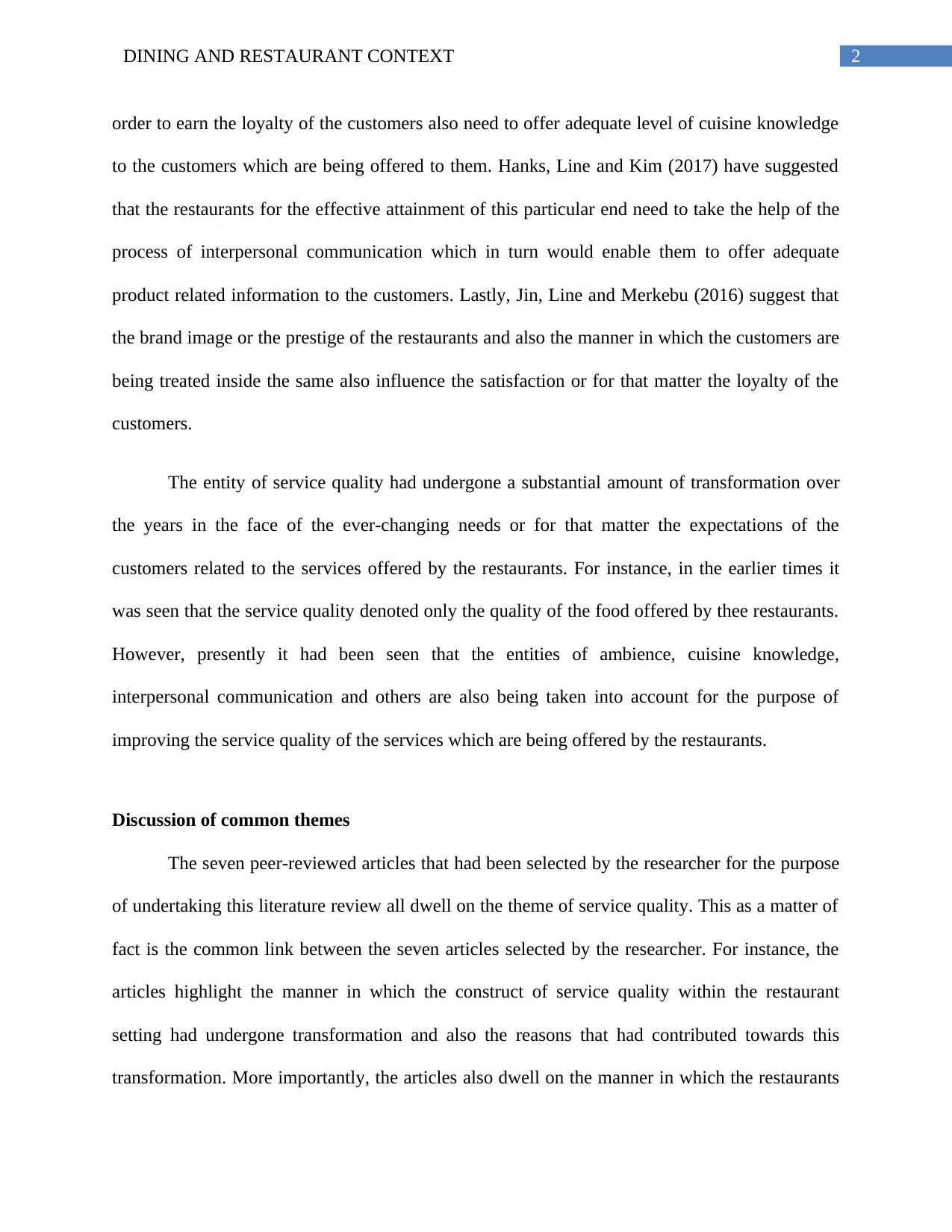
2DINING AND RESTAURANT CONTEXT
order to earn the loyalty of the customers also need to offer adequate level of cuisine knowledge
to the customers which are being offered to them. Hanks, Line and Kim (2017) have suggested
that the restaurants for the effective attainment of this particular end need to take the help of the
process of interpersonal communication which in turn would enable them to offer adequate
product related information to the customers. Lastly, Jin, Line and Merkebu (2016) suggest that
the brand image or the prestige of the restaurants and also the manner in which the customers are
being treated inside the same also influence the satisfaction or for that matter the loyalty of the
customers.
The entity of service quality had undergone a substantial amount of transformation over
the years in the face of the ever-changing needs or for that matter the expectations of the
customers related to the services offered by the restaurants. For instance, in the earlier times it
was seen that the service quality denoted only the quality of the food offered by thee restaurants.
However, presently it had been seen that the entities of ambience, cuisine knowledge,
interpersonal communication and others are also being taken into account for the purpose of
improving the service quality of the services which are being offered by the restaurants.
Discussion of common themes
The seven peer-reviewed articles that had been selected by the researcher for the purpose
of undertaking this literature review all dwell on the theme of service quality. This as a matter of
fact is the common link between the seven articles selected by the researcher. For instance, the
articles highlight the manner in which the construct of service quality within the restaurant
setting had undergone transformation and also the reasons that had contributed towards this
transformation. More importantly, the articles also dwell on the manner in which the restaurants
order to earn the loyalty of the customers also need to offer adequate level of cuisine knowledge
to the customers which are being offered to them. Hanks, Line and Kim (2017) have suggested
that the restaurants for the effective attainment of this particular end need to take the help of the
process of interpersonal communication which in turn would enable them to offer adequate
product related information to the customers. Lastly, Jin, Line and Merkebu (2016) suggest that
the brand image or the prestige of the restaurants and also the manner in which the customers are
being treated inside the same also influence the satisfaction or for that matter the loyalty of the
customers.
The entity of service quality had undergone a substantial amount of transformation over
the years in the face of the ever-changing needs or for that matter the expectations of the
customers related to the services offered by the restaurants. For instance, in the earlier times it
was seen that the service quality denoted only the quality of the food offered by thee restaurants.
However, presently it had been seen that the entities of ambience, cuisine knowledge,
interpersonal communication and others are also being taken into account for the purpose of
improving the service quality of the services which are being offered by the restaurants.
Discussion of common themes
The seven peer-reviewed articles that had been selected by the researcher for the purpose
of undertaking this literature review all dwell on the theme of service quality. This as a matter of
fact is the common link between the seven articles selected by the researcher. For instance, the
articles highlight the manner in which the construct of service quality within the restaurant
setting had undergone transformation and also the reasons that had contributed towards this
transformation. More importantly, the articles also dwell on the manner in which the restaurants
⊘ This is a preview!⊘
Do you want full access?
Subscribe today to unlock all pages.

Trusted by 1+ million students worldwide
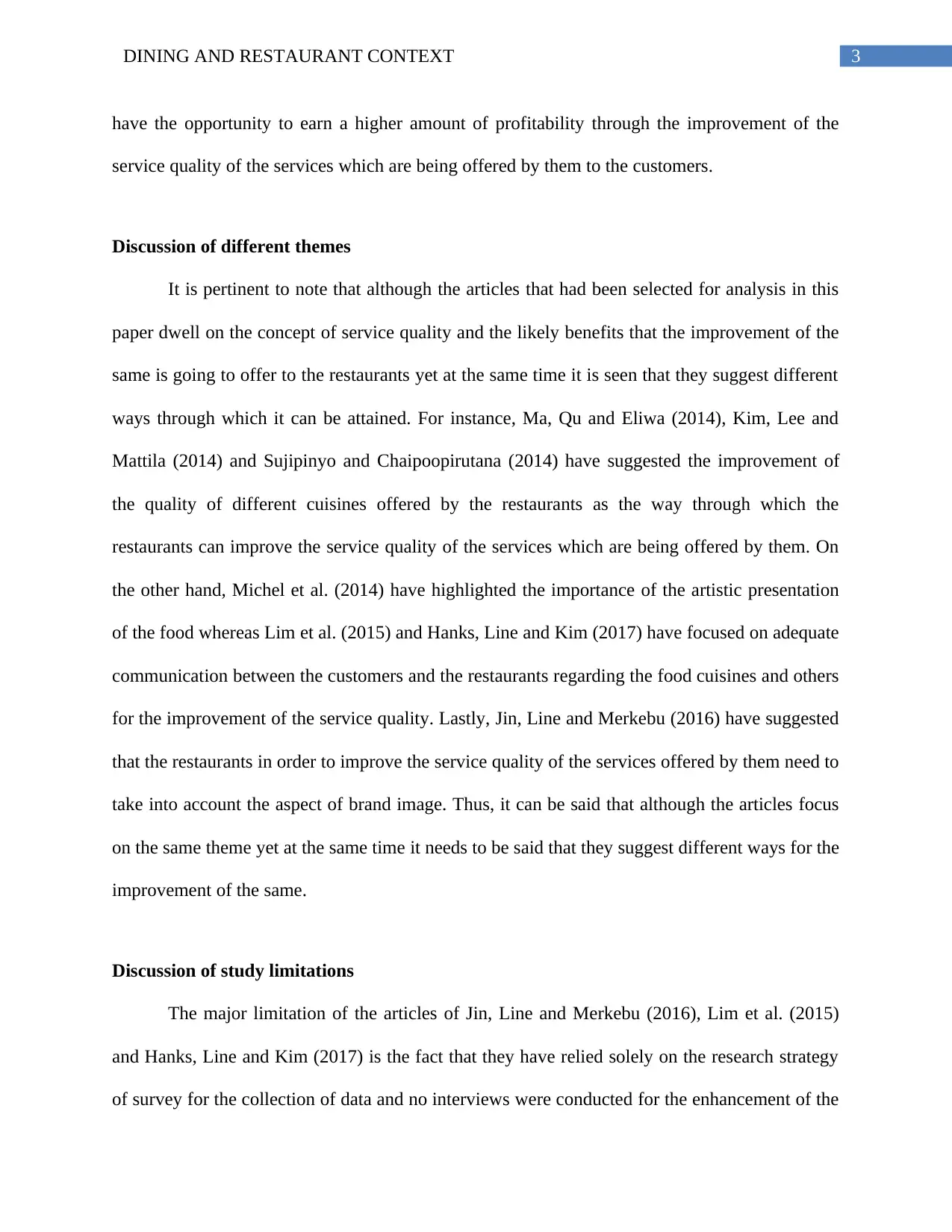
3DINING AND RESTAURANT CONTEXT
have the opportunity to earn a higher amount of profitability through the improvement of the
service quality of the services which are being offered by them to the customers.
Discussion of different themes
It is pertinent to note that although the articles that had been selected for analysis in this
paper dwell on the concept of service quality and the likely benefits that the improvement of the
same is going to offer to the restaurants yet at the same time it is seen that they suggest different
ways through which it can be attained. For instance, Ma, Qu and Eliwa (2014), Kim, Lee and
Mattila (2014) and Sujipinyo and Chaipoopirutana (2014) have suggested the improvement of
the quality of different cuisines offered by the restaurants as the way through which the
restaurants can improve the service quality of the services which are being offered by them. On
the other hand, Michel et al. (2014) have highlighted the importance of the artistic presentation
of the food whereas Lim et al. (2015) and Hanks, Line and Kim (2017) have focused on adequate
communication between the customers and the restaurants regarding the food cuisines and others
for the improvement of the service quality. Lastly, Jin, Line and Merkebu (2016) have suggested
that the restaurants in order to improve the service quality of the services offered by them need to
take into account the aspect of brand image. Thus, it can be said that although the articles focus
on the same theme yet at the same time it needs to be said that they suggest different ways for the
improvement of the same.
Discussion of study limitations
The major limitation of the articles of Jin, Line and Merkebu (2016), Lim et al. (2015)
and Hanks, Line and Kim (2017) is the fact that they have relied solely on the research strategy
of survey for the collection of data and no interviews were conducted for the enhancement of the
have the opportunity to earn a higher amount of profitability through the improvement of the
service quality of the services which are being offered by them to the customers.
Discussion of different themes
It is pertinent to note that although the articles that had been selected for analysis in this
paper dwell on the concept of service quality and the likely benefits that the improvement of the
same is going to offer to the restaurants yet at the same time it is seen that they suggest different
ways through which it can be attained. For instance, Ma, Qu and Eliwa (2014), Kim, Lee and
Mattila (2014) and Sujipinyo and Chaipoopirutana (2014) have suggested the improvement of
the quality of different cuisines offered by the restaurants as the way through which the
restaurants can improve the service quality of the services which are being offered by them. On
the other hand, Michel et al. (2014) have highlighted the importance of the artistic presentation
of the food whereas Lim et al. (2015) and Hanks, Line and Kim (2017) have focused on adequate
communication between the customers and the restaurants regarding the food cuisines and others
for the improvement of the service quality. Lastly, Jin, Line and Merkebu (2016) have suggested
that the restaurants in order to improve the service quality of the services offered by them need to
take into account the aspect of brand image. Thus, it can be said that although the articles focus
on the same theme yet at the same time it needs to be said that they suggest different ways for the
improvement of the same.
Discussion of study limitations
The major limitation of the articles of Jin, Line and Merkebu (2016), Lim et al. (2015)
and Hanks, Line and Kim (2017) is the fact that they have relied solely on the research strategy
of survey for the collection of data and no interviews were conducted for the enhancement of the
Paraphrase This Document
Need a fresh take? Get an instant paraphrase of this document with our AI Paraphraser
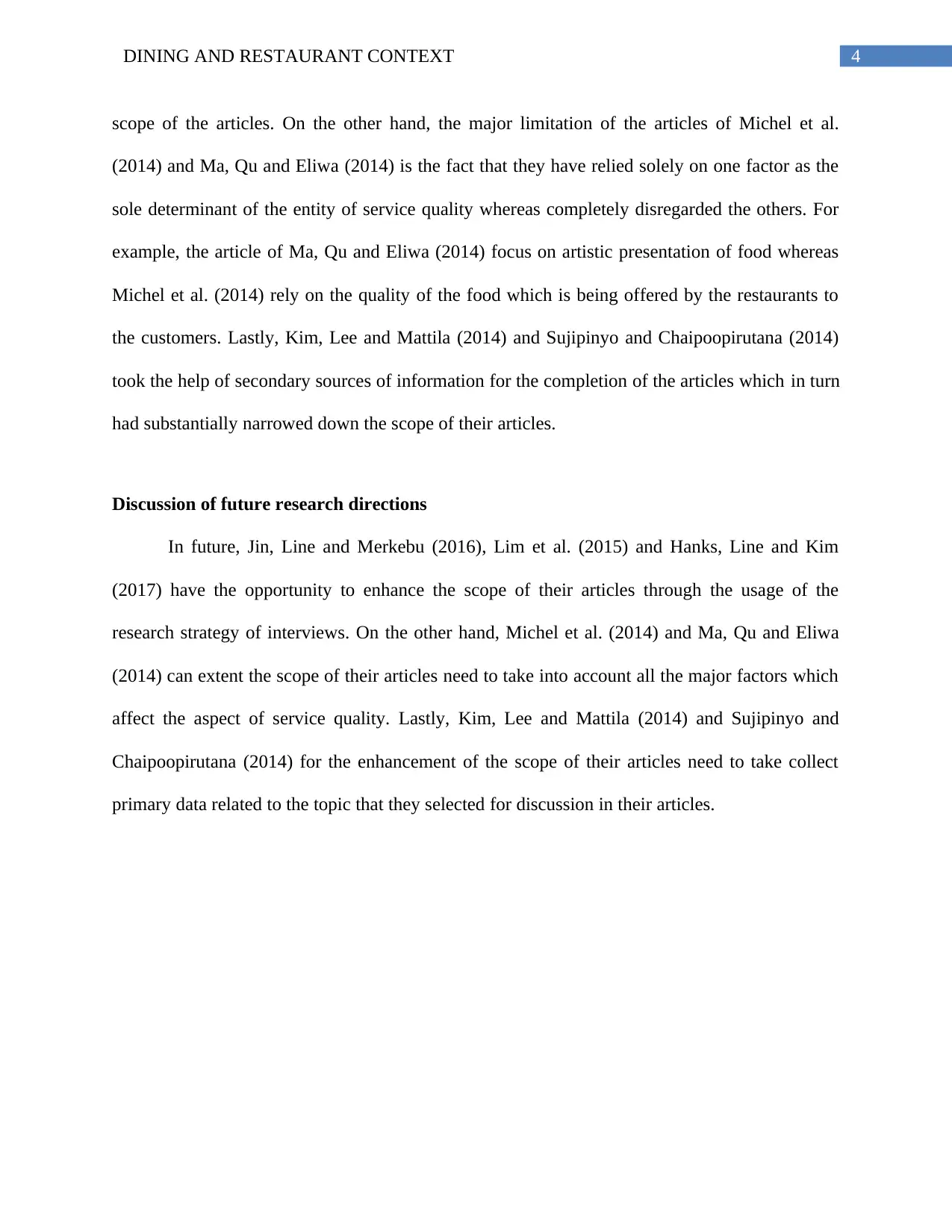
4DINING AND RESTAURANT CONTEXT
scope of the articles. On the other hand, the major limitation of the articles of Michel et al.
(2014) and Ma, Qu and Eliwa (2014) is the fact that they have relied solely on one factor as the
sole determinant of the entity of service quality whereas completely disregarded the others. For
example, the article of Ma, Qu and Eliwa (2014) focus on artistic presentation of food whereas
Michel et al. (2014) rely on the quality of the food which is being offered by the restaurants to
the customers. Lastly, Kim, Lee and Mattila (2014) and Sujipinyo and Chaipoopirutana (2014)
took the help of secondary sources of information for the completion of the articles which in turn
had substantially narrowed down the scope of their articles.
Discussion of future research directions
In future, Jin, Line and Merkebu (2016), Lim et al. (2015) and Hanks, Line and Kim
(2017) have the opportunity to enhance the scope of their articles through the usage of the
research strategy of interviews. On the other hand, Michel et al. (2014) and Ma, Qu and Eliwa
(2014) can extent the scope of their articles need to take into account all the major factors which
affect the aspect of service quality. Lastly, Kim, Lee and Mattila (2014) and Sujipinyo and
Chaipoopirutana (2014) for the enhancement of the scope of their articles need to take collect
primary data related to the topic that they selected for discussion in their articles.
scope of the articles. On the other hand, the major limitation of the articles of Michel et al.
(2014) and Ma, Qu and Eliwa (2014) is the fact that they have relied solely on one factor as the
sole determinant of the entity of service quality whereas completely disregarded the others. For
example, the article of Ma, Qu and Eliwa (2014) focus on artistic presentation of food whereas
Michel et al. (2014) rely on the quality of the food which is being offered by the restaurants to
the customers. Lastly, Kim, Lee and Mattila (2014) and Sujipinyo and Chaipoopirutana (2014)
took the help of secondary sources of information for the completion of the articles which in turn
had substantially narrowed down the scope of their articles.
Discussion of future research directions
In future, Jin, Line and Merkebu (2016), Lim et al. (2015) and Hanks, Line and Kim
(2017) have the opportunity to enhance the scope of their articles through the usage of the
research strategy of interviews. On the other hand, Michel et al. (2014) and Ma, Qu and Eliwa
(2014) can extent the scope of their articles need to take into account all the major factors which
affect the aspect of service quality. Lastly, Kim, Lee and Mattila (2014) and Sujipinyo and
Chaipoopirutana (2014) for the enhancement of the scope of their articles need to take collect
primary data related to the topic that they selected for discussion in their articles.
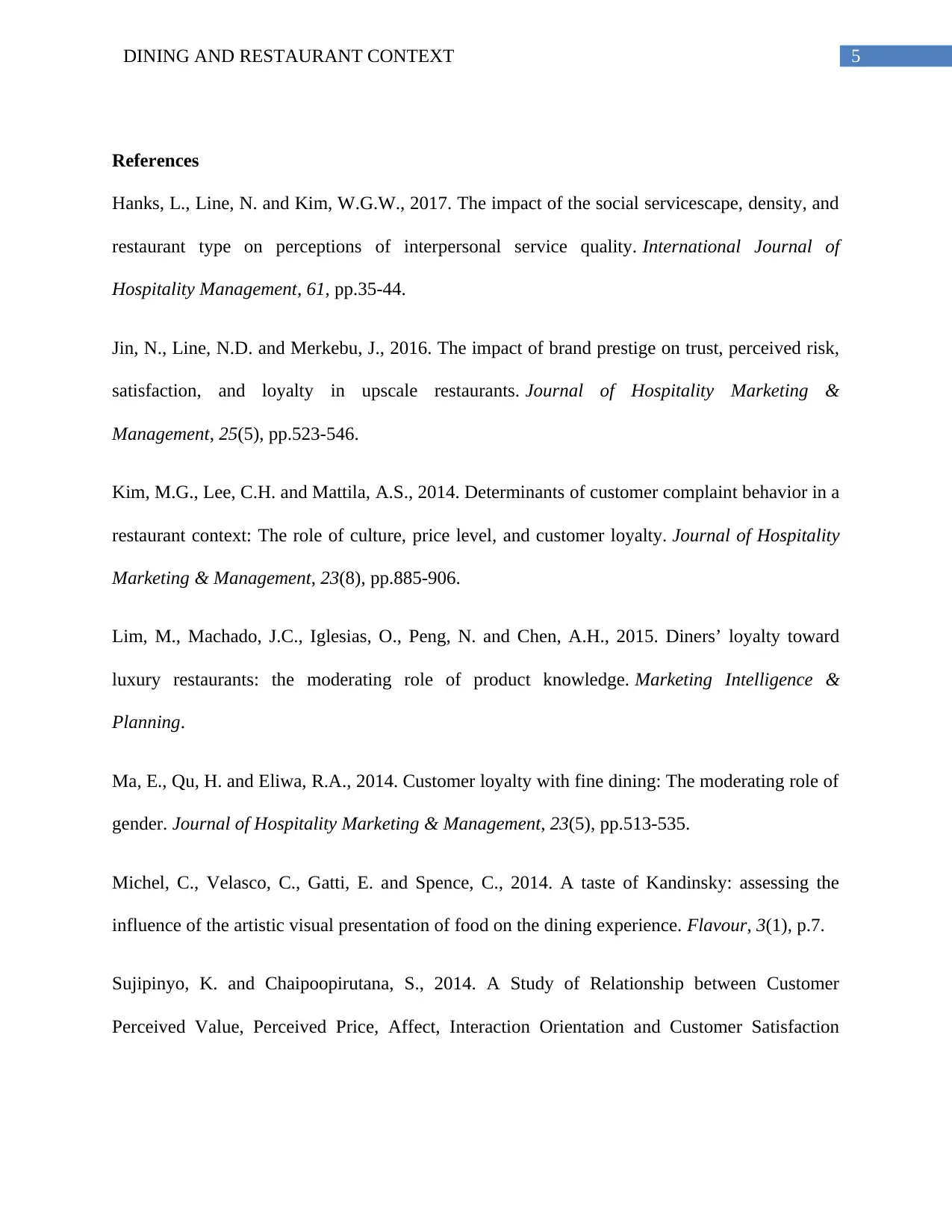
5DINING AND RESTAURANT CONTEXT
References
Hanks, L., Line, N. and Kim, W.G.W., 2017. The impact of the social servicescape, density, and
restaurant type on perceptions of interpersonal service quality. International Journal of
Hospitality Management, 61, pp.35-44.
Jin, N., Line, N.D. and Merkebu, J., 2016. The impact of brand prestige on trust, perceived risk,
satisfaction, and loyalty in upscale restaurants. Journal of Hospitality Marketing &
Management, 25(5), pp.523-546.
Kim, M.G., Lee, C.H. and Mattila, A.S., 2014. Determinants of customer complaint behavior in a
restaurant context: The role of culture, price level, and customer loyalty. Journal of Hospitality
Marketing & Management, 23(8), pp.885-906.
Lim, M., Machado, J.C., Iglesias, O., Peng, N. and Chen, A.H., 2015. Diners’ loyalty toward
luxury restaurants: the moderating role of product knowledge. Marketing Intelligence &
Planning.
Ma, E., Qu, H. and Eliwa, R.A., 2014. Customer loyalty with fine dining: The moderating role of
gender. Journal of Hospitality Marketing & Management, 23(5), pp.513-535.
Michel, C., Velasco, C., Gatti, E. and Spence, C., 2014. A taste of Kandinsky: assessing the
influence of the artistic visual presentation of food on the dining experience. Flavour, 3(1), p.7.
Sujipinyo, K. and Chaipoopirutana, S., 2014. A Study of Relationship between Customer
Perceived Value, Perceived Price, Affect, Interaction Orientation and Customer Satisfaction
References
Hanks, L., Line, N. and Kim, W.G.W., 2017. The impact of the social servicescape, density, and
restaurant type on perceptions of interpersonal service quality. International Journal of
Hospitality Management, 61, pp.35-44.
Jin, N., Line, N.D. and Merkebu, J., 2016. The impact of brand prestige on trust, perceived risk,
satisfaction, and loyalty in upscale restaurants. Journal of Hospitality Marketing &
Management, 25(5), pp.523-546.
Kim, M.G., Lee, C.H. and Mattila, A.S., 2014. Determinants of customer complaint behavior in a
restaurant context: The role of culture, price level, and customer loyalty. Journal of Hospitality
Marketing & Management, 23(8), pp.885-906.
Lim, M., Machado, J.C., Iglesias, O., Peng, N. and Chen, A.H., 2015. Diners’ loyalty toward
luxury restaurants: the moderating role of product knowledge. Marketing Intelligence &
Planning.
Ma, E., Qu, H. and Eliwa, R.A., 2014. Customer loyalty with fine dining: The moderating role of
gender. Journal of Hospitality Marketing & Management, 23(5), pp.513-535.
Michel, C., Velasco, C., Gatti, E. and Spence, C., 2014. A taste of Kandinsky: assessing the
influence of the artistic visual presentation of food on the dining experience. Flavour, 3(1), p.7.
Sujipinyo, K. and Chaipoopirutana, S., 2014. A Study of Relationship between Customer
Perceived Value, Perceived Price, Affect, Interaction Orientation and Customer Satisfaction
⊘ This is a preview!⊘
Do you want full access?
Subscribe today to unlock all pages.

Trusted by 1+ million students worldwide

6DINING AND RESTAURANT CONTEXT
towards Thai Suki Restaurant. In International Conference in Business, Law and Coporate
Social Responsibility.
towards Thai Suki Restaurant. In International Conference in Business, Law and Coporate
Social Responsibility.
1 out of 7
Related Documents
Your All-in-One AI-Powered Toolkit for Academic Success.
+13062052269
info@desklib.com
Available 24*7 on WhatsApp / Email
![[object Object]](/_next/static/media/star-bottom.7253800d.svg)
Unlock your academic potential
Copyright © 2020–2025 A2Z Services. All Rights Reserved. Developed and managed by ZUCOL.





